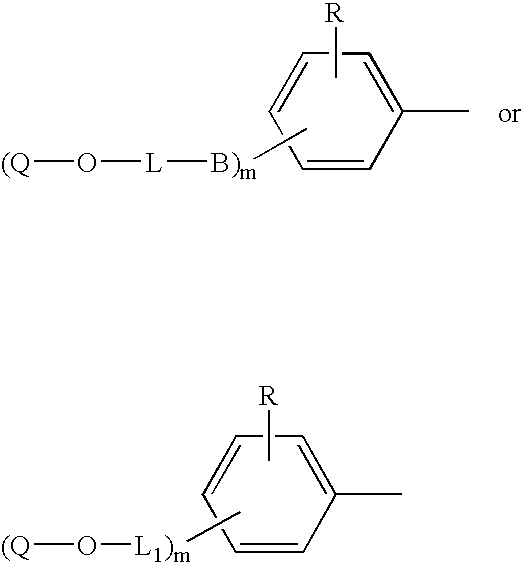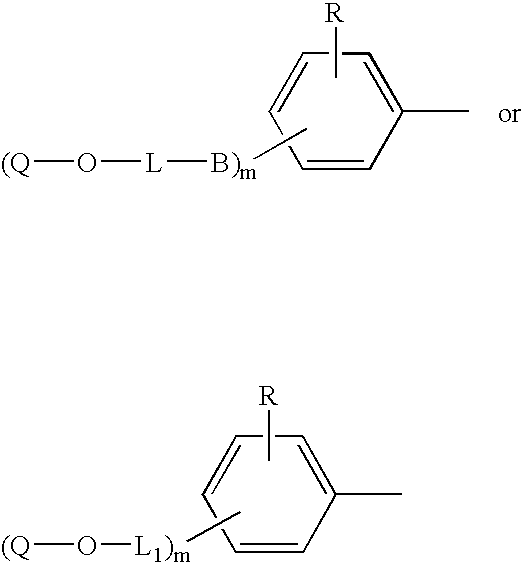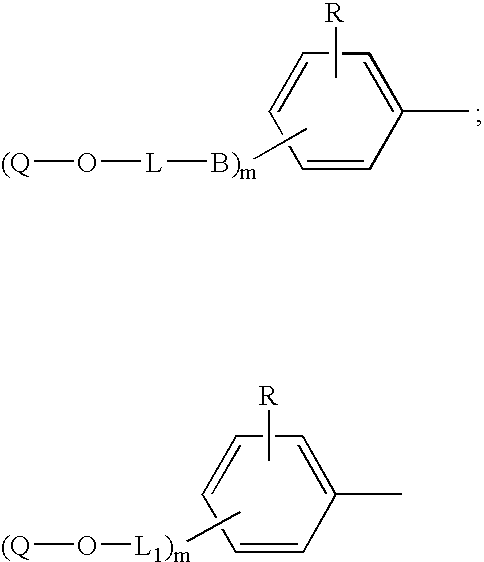Copolymerizable azo compounds and articles containing them
a technology of polymerizable azo and compounds, applied in the field of polymerizable azo compounds, can solve the problems of increased production and material costs, unsuitability of artificial lens materials, and complicated manufacturing processes
- Summary
- Abstract
- Description
- Claims
- Application Information
AI Technical Summary
Benefits of technology
Problems solved by technology
Method used
Image
Examples
example 1a
[0173]To a solution prepared by adding conc. HCl (36 mL) to water (100 mL) is added with stirring 4-aminophenethyl alcohol (16.44 g, 0.12 mol, Aldrich). The solution is cooled and a solution of sodium nitrite (8.64 g, 0.15 mol) dissolved in water (32 mL) is added below 3° C. and stirring continued for 2 hours at 0-3° C. A coupling solution of 3-methyl-1-phenyl-2-pyrazolin-5-one (20.9 g, 0.12 mol, Aldrich) dissolved in water (800 mL) containing 50% aqueous sodium hydroxide (26.5 g) is prepared. The solution is stirred and cooled in an ice water bath and portions of ice added for internal cooling. The diazonium salt solution, as prepared above, is added dropwise with stirring and cooling continued to maintain temperature at about 3-5° C. Stirring is continued at about 5° C. for about 1.0 hour and the solid yellow product is collected by vacuum filtration, washed with water and then dried in air. The yield is 37.8 g (97.9% of one theoretical) of product which had the following structur...
example 1b
[0175]A portion of the product from Example 1a (35.4 g, 0.11 mol), 4-dimethylaminopyridine (DMAP), (0.7 g, 6 mmol), hydroquinone (0.35 g) and triethylamine (14.5 g, 0.375 mol) are added to dry acetone (275 mL) with stirring. Methacrylic anhydride (21.7 g, 0.14 mol, Aldrich) is added and the reaction mixture stirred and heated at reflux. After 1.5 hour the progress of the reaction is checked by thin-layer chromatography (TLC). Some hydroxyl containing starting material is still present. Additional methacrylic anhydride (5 mL) is added and heating and stirring continued at reflux temperature for 1.0 hour.
[0176]Reaction is complete by TLC. The reaction mixture is allowed to cool to room temperature and a yellow solid product results. Cold methanol (100 mL) is added to further precipitate the product and the mixture is stirred and cooled to about 15° C. The product is collected, washed with cold methanol and dried in air (yield—36.6 g, 78.3% of the theoretical yield). The precipitate ha...
example 2a
[0178]Acetic acid (180 mL) is added to water (120 mL) with stirring and the solution cooled in an ice / water bath while methyl anthranilate (15.1 g, 0.10 mol) is added below 25° C. The solution is further cooled and 40% nitrosylsulfuric acid (32.0 g, 0.1 mol) added dropwise below 5° C. Stirring is continued for 2.0 hours at 0-5° C. and half of the diazonium solution is added to a cold solution of 3-methyl-1-phenyl-2-pyrazolin-5-one (17.4 g, 0.10 mol, Aldrich) dissolved in cold water (500 mL) to which 50% NaOH (40.0 g) has been added. Ice is added during the addition of the diazonium salt to keep the temperature at about 0-2° C. A thick slurry of yellow solid results and cold water (400 mL) is added to facilitate stirring. An additional quantity (50 g) of 50% NaOH solution is added and then the remaining half of the diazonium salt solution is added gradually still keeping the temperature at 0-5° C. At this point, the mixture is neutral to Congo Red test paper (pH of about 4). The mixt...
PUM
| Property | Measurement | Unit |
|---|---|---|
| wavelengths | aaaaa | aaaaa |
| wavelengths | aaaaa | aaaaa |
| wavelength | aaaaa | aaaaa |
Abstract
Description
Claims
Application Information
 Login to View More
Login to View More - R&D
- Intellectual Property
- Life Sciences
- Materials
- Tech Scout
- Unparalleled Data Quality
- Higher Quality Content
- 60% Fewer Hallucinations
Browse by: Latest US Patents, China's latest patents, Technical Efficacy Thesaurus, Application Domain, Technology Topic, Popular Technical Reports.
© 2025 PatSnap. All rights reserved.Legal|Privacy policy|Modern Slavery Act Transparency Statement|Sitemap|About US| Contact US: help@patsnap.com



